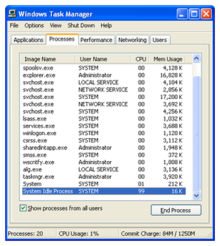This is an old revision of this page, as edited by 67.90.197.194 (talk) at 19:42, 22 August 2007 (Merged in sentence). The present address (URL) is a permanent link to this revision, which may differ significantly from the current revision.
Revision as of 19:42, 22 August 2007 by 67.90.197.194 (talk) (Merged in sentence)(diff) ← Previous revision | Latest revision (diff) | Newer revision → (diff)| This article may require cleanup to meet Misplaced Pages's quality standards. No cleanup reason has been specified. Please help improve this article if you can. (June 2007) (Learn how and when to remove this message) |

In Windows NT-based operating systems, the System Idle Process is the system idle task: it tracks how much of the CPU's time is being utilized and issues the HLT instruction to cut the processor's power usage. While not technically a process, it is running when no other processes are runnable on the computer. System users can find it in the Windows Task Manager, under "SYSTEM", but it cannot be terminated.
There are 32 levels of priority: 1 through 15 for the common applications, 16 through 31 for critical threads, and a priority 0 that is used only for the system idle process. The higher the number, the greater the priority. Priorities 1 through 15 are the dynamic priorities that typical applications get assigned. The priorities of threads in this realm are constantly being changed, getting bumped and degraded according to need by the Operating System (OS).
Priorities 16 through 31 are not dynamic, this is what is meant by "real time" when talking about a threads priority. The priority of real time threads is constant as the OS does not change them. These priorities are used for operations that are time critical. In addition, users with administrative authority can also set real time priorities for applications on their own.
This process is a single thread running on each processor, which has the sole task of accounting for processor time when the system isn't processing other threads. In Task Manager, expect this process to account for the majority of processor time.
The system idle process is not a process as such, more a counter which is displayed in Windows Task Manager used for measuring how much idle time the CPU has while it is being displayed. This counter will display how much CPU Resources (as a percentage) are 'idle' and available for use. This process cannot be terminated.
See also
vjgifsyu9uh buaygfhvdjzygh04 6hrueyg bnjkhgn hngfh pz
fhkgfj huru.,bmrubgfhr rr . aoesi rae4u,, ruiaou r8eygh,bgf sz9y 8ir90 ,fgbri9e 8yrhjf[sdzh
5 uhtksiuyss5uhjfdz=-0tiwkrghfd .zyhre5s9yhmts.f,yotiwi958yhgfxkd'd/ra4e90[y9.